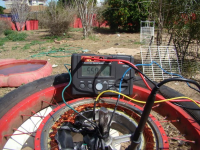mazzola
1 mW
I've been reading UL 2271's standards for battery safety but am having trouble understanding how the "Dielectric Voltage Withstand Test"/Hipot would work. The test is meant to ensure the battery has sufficient insulation between its enclosure and the high voltage circuits within. But I don't quite understand the test procedure and how it wouldn't fry the battery under test, even a well-designed one.
The procedure calls for applying 2.8 times the rated voltage of a battery (e.g. 134.4v for a 48v battery) between its high voltage circuit and the enclosure for 1 minute and measuring if there is any arcing.
But if you apply 2.8x the rated voltage wouldn't you fry the BMS? The test procedure allows you to disconnect/bypass "semiconductors and similar electronics liable to be damaged", so you could remove the BMS but then what is preventing the cells from getting over-charged and go into thermal runaway?
The procedure also allows you to disconnect the cells during application of the voltage but I don't see how this is really feasible if the cells are welded or fused to the busbars (i.e. the high voltage circuit).
The procedure calls for applying 2.8 times the rated voltage of a battery (e.g. 134.4v for a 48v battery) between its high voltage circuit and the enclosure for 1 minute and measuring if there is any arcing.
But if you apply 2.8x the rated voltage wouldn't you fry the BMS? The test procedure allows you to disconnect/bypass "semiconductors and similar electronics liable to be damaged", so you could remove the BMS but then what is preventing the cells from getting over-charged and go into thermal runaway?
The procedure also allows you to disconnect the cells during application of the voltage but I don't see how this is really feasible if the cells are welded or fused to the busbars (i.e. the high voltage circuit).


